
- Выступление на ШМО учителей иностранных языков «Формирование читательской грамотности как метод подготовки к итоговой аттестации по предметам гуманитарного цикла на уроках и внеурочных занятиях. Практическая мастерская», 02.11.2022
Результаты проведенного исследования PISA показали, что в России существуют большие проблемы в формировании грамотности чтения, понимаемой в широком смысле слова как способность учащихся к осмыслению текстов различного содержания, а также к использованию прочитанного в различных жизненных ситуациях.
По всем трем шкалам, выделенным в исследовании («нахождение информации», «интерпретация текста» и «рефлексия и оценка»), результаты российских учащихся значительно ниже результатов учащихся из многих европейских стран и соответствуют второму уровню грамотности чтения. Из результатов исследования грамотности чтения следует вывод о необходимости поиска более разнообразных и эффективных путей обучения школьников работе с текстами различного содержания, характера и формата.
Что же такое читательская грамотность? Это «способность человека понимать и использовать письменные тексты, размышлять о них и заниматься чтением для того, чтобы достигать своих целей, расширять свои знания и возможности, участвовать в социальной жизни».
Чтение - это процесс восприятия и смысловой переработки (понимания) письменной речи. Чтение - это и процесс коммуникации с помощью речи. Цель читателя - преобразование содержания прочитанного в смысл «для себя», то есть понимание.
Читательская грамотность - базовое направление функциональной грамотности. Какое бы задание не получил учащийся, нужно сначала это задание ПРОЧИТАТЬ.
Развитие читательской грамотности - это направление очень актуальное и самое востребованное. В этом направлении работают все школы страны, подготавливая учащихся к ВПР, а выпускников к ГИА.
Функциональное чтение – это чтение с целью поиска информации для решения конкретной задачи или выполнения определенного задания. При функциональном чтении применяются приемы просмотрового чтения (сканирования) и аналитического чтения (выделение ключевых слов, подбор цитат, составление схем, графиков, таблиц). Ученик, у которого сформированы навыки функционального чтения, может «свободно использовать навыки чтения и письма для получения информации из текста – для его понимания, сжатия, преобразования и т.д., а также умеет пользоваться различными видами чтения (изучающим, просмотровым, ознакомительным
Выделяют три группы читательских умений:
1) Ориентация в содержании текста (умение определять главную тему, общую цель или назначение текста; выбирать из текста или придумать заголовок; формулировать тезис, выражающий общий смысл текста; объяснять порядок частей, содержащихся в тексте; находить в тексте требуемую информацию и т.п.).
2) Преобразование и интерпретация текста (умение преобразовывать текст, используя новые формы представления информации: формулы, графики, диаграммы, таблицы; сравнивать и противопоставлять заключённую в тексте информацию разного характера; обнаруживать в тексте доводы в подтверждение выдвинутых тезисов и т.п.).
3) Оценка информации (откликаться на содержание текста; оценивать утверждения, сделанные в тексте, исходя из своих представлений о мире; находить доводы в защиту своей точки зрения, умение использовать информацию из текста (для решения практических задач и т.п.).
Овладение этими умениями и означает «смысловое чтение», которое является фундаментом всех обозначенных в новом стандарте результатов образования.
В своей практике учителя часто сталкиваются с многочисленными проблемами и затруднениями обучающихся при работе с иноязычным текстом, а именно: учащиеся не знают значений многих слов,не умеют читать диаграммы,не умеют озаглавить текст, не понимают смысла написанного, не могут выделить ключевые слова, не в состоянии сформулировать вопрос, не могут выбрать способ решения задачи, не умеют актуализировать наличные умения, не могут перенести знания и умения из одной области на другую, часто подменяют задание на более привычное, знакомое.
Для развития этих умений мы можем использовать и знакомить учащихся со следующими видами текстов:
Соответственно мы должны учить детей:
Эти умения согласно PISA считаются высшим уровнем развития читательской грамотности.
В формировании функциональной грамотности учащихся способствуют задания с использованием сплошных и несплошных текстов.
К сплошным текстам относят тексты, читаемые в повседневной жизни:
· описание (отрывок из рассказа, стихотворения, описание человека, места, предмета и т.д.);
· повествование (рассказ, стихотворение, повесть, басня, письмо, статья в газете или журнале, статья в учебнике, инструкция, реклама, краткое содержание фильма, спектакля, пост блога, материалы различных сайтов и т.д.);
· рассуждение (сочинение-размышление, комментарий, аргументация собственного мнения).
К несплошным текстам относятся графики, диаграммы, таблицы, схемы (кластеры), географические карты и карты местности, план помещения, входные билеты, расписание движения транспорта, карты сайтов и т.д.
При выполнении работ с несплошными текстами происходит формирование умений описания и перехода от языка образа к языку мыслей: учащийся составляет опорные слова по данному заданию, заполняет данные шаблоны, отвечает на вопросы. Однако без специфической лексики, будет, сложно заполнять какой бы то ни было образец-шаблон. Поэтому в работе предлагается познакомиться с базовой лексикой, полезными фразами и оборотами, которыми необходимо будет оперировать при описании графиков. Графики, диаграммы и таблицы содержат большое количество информации, представленной в доступном и легко понимаемом виде.
Когда вы работаете с графиком или диаграммой, важно понять ее цель, т.е. каким образом подана информация, и что именно она показывает: частоту выполнения действий, процентное соотношение долей, делит что-либо на категории, показывает темп роста.
Внимательно прочтите задание и изучите график (диаграмму, таблицу), сконцентрируйтесь на фактах. Выберите, какая информация является важной, а какую можно и опустить. Составьте примерный план, в котором будет введение, основная часть, заключение.
Примеры заданий
5 класс 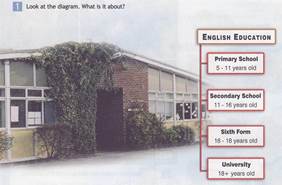
The diagram is about
Рассмотреть диаграмму и составить сообщение. Учащимся можно дать задание составить не одно предложение по образцу, а краткий обзор диаграммы.
The pie chart illustrates… The biggest slice of the pie-chart is taken up by ….
We can see that a large number of…prefer… In contrast a very small number of… are fond of…Only… per cent of … like …
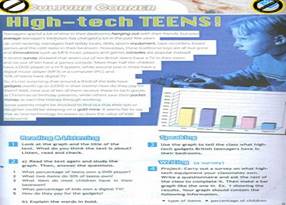
Проанализировать диаграмму устно, провести опрос и составить подобную диаграмму о российских школьниках.
Можно предложить примерную схему ответа:
The bar chart shows us the number of … in the houses of …The chart compares the percentage of using… by… More than half … have …while only … per cent… own … The … percentage of kids own … The most popular gadgets are…
The least spread high equipment is…
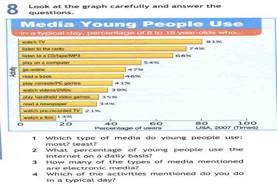
Понять и проанализировать график о том, какие СМИ использует молодежь.
The graph shows the rate of popularity of… among…
Figure 1 shows …of … watching… .
In second place of the graph is…
The graph compares the chief uses of the … by…
About …% of the …. Less than …% of …
The survey results shown in the graph may help to
Подбираются специальные текстовые материалы, если речь идет о воображении,
подбираются описательные тексты, диалог с тестом — это, там должно быть
движение сюжета, скрытые вопросы, возможность прогнозировать, работа над словом
везде важна и выход на слово тоже. Важно пошаговое предъявление материала,
тренировка и самоконтроль.
Именно на основе работы с такими текстами формируется способность решать стандартные жизненные задачи в различных сферах жизнедеятельности: прочитать и понять объявление (рекламу, афишу т.д.), заполнить бланк (миграционную карту, анкету и т.д.), написать письмо, e-mail и т.д. На основе данных текстов спроектированы учебные задачи, направленные на формирование функциональной грамотности в области чтения.
Материал для составления заданий по развитию читательской грамотности следует выбирать из жизненных ситуации:
Основными этапами работы с текстом при формировании читательской компетенции учащихся являются:
1. Предтекстовый (Pre-reading)
Задачами данного этапа являются
Можно выделить следующие группы упражнений:
1. Упражнения на соотнесение слова с темой.
- Заполните пропуски в предложении одним из указанных слов.
- Найдите и замените слова в предложении, которые не подходят по смыслу.
- В каждой группе слов найдите одно с наиболее общим значением.
- Каждой группе слов найдите одно, не принадлежащее по значению к этой группе.
- Назовите слово, с которым ассоциируются все слова данного тематического ряда.
2. Упражнения на понимание лексико-тематической основы текста.
- Прочитайте опорные слова и словосочетания текста и назовите его тему.
- Запишите ключевое слово заголовка и составьте схему, заполняя её ассоциациями.
- Взгляните на фотографию и выберите из списка слов те, которые подходят для описания ситуации, изображённой на ней.
- Ознакомьтесь с новыми словами и словосочетаниями (которые даны с переводом) и, не читая текст, скажите, о чём может идти в нём речь.
- Расположите слова и фразы, определяющие содержание текста, в последовательности происходящих событий.
3. Упражнения в работе с заглавием текста.
- Прочитайте заглавие и скажите, о чём (о ком), по-вашему, мнению, будет идти речь в тексте.
- Переведите заглавие и ответьте на вопросы:
4. Упражнение в опознавании интернационализмов.
- Найдите во второй колонке перевод к каждому слову из первой (без словаря), опираясь на графический образ слов.
- Подчеркните в данных утверждениях интернациональные слова, определите их значение в родном языке и иностранном языках.
- Распределите весь список слов на две колонки: интернационализмы и «ложные -друзья переводчика», предварительно прочитав следующие словосочетания.
2. Текстовые (While-reading) стратегии
Направлены на понимание текста и формирование его интерпретации у читающего, размышление во время чтения о том, что и как читает обучающийся и насколько хорошо понимает прочитанное.
На данном этапе учитель может предложить учащимся:
3. Послетекстовые (Post-reading) стратегии
Необходимы для проверки понимания прочитанного и служат средством контроля формирования умений смыслового чтения и возможным использованием полученной информации в будущем.
На этом этапе учитель может предложить учащимся:
Основные требования к тексту, направленному на формирование навыков функциональной читательской грамотности:
1) Текст должен быть ученику интересен.
2) Текст должен содержать неизвестную ученику информацию. Но, при этом, актуальную для ученика.
3) Уровень трудности текста должен соответствовать возрасту ученика.
4) Объем текста не должен превышать норму (исходя из уровня и возраста учащихся).
5) Текст должен развивать кругозор.
6) Текст может быть взят из "реальной жизни"
7)Текст не должен быть перегружен цифрами, датами, терминами.
8) Иллюстрации не отвлекают, а помогают разобраться в содержании текста.
9) Текст должен быть структурирован: заголовок, абзацы, прямая речь и т.д.
10) При необходимости нужно адаптировать текст.
11) В тексте иллюстрации должны способствовать развитию познавательной активности.
12) В тексте не должно быть ошибок.
13) Содержание текста должно опираться на жизненный опыт ребенка.
Для того, чтобы заинтересовать обучающихся на уроках при работе с текстом можно применять такие современные педагогические технологии и методы, которые заинтересовывают и мотивируют обучающихся:
·технология развития критического мышления через чтение и письмо;
·метод проектов;
·технология сотрудничества;
·информационно-коммуникационная технология
Читательская грамотность рассматривается сегодня как одна из самых важных компетентностей, характеризующих готовность к жизни в современном обществе. Формирование читательской грамотности на уроках иностранного языка предполагает работу над развитием следующих умений у учащихся:
Кроме вышеуказанных умений, в работе с текстом следует обратить особое внимание на развитие таких умений как:
В связи с чем, для развития читательской грамотности на уроках английского языка можно использовать различные упражнения, построенные на работе с разными форматами текстов.
TEXT 1
1. Read the text about Bob Wilson.
My name is Bob, Bob Wilson. My holidays began yesterday. It was a wonderful day. I was up early in the morning. The weather was wonderful. I was happy! I went to the bathroom and had a shower. I dressed and went to the kitchen. My mother gave me breakfast - some salad, porridge and a ham sandwich. I drank coffee with milk and was ready for my morning walk with my friends. We were all free - no school, no classes.
We met at the bus stop at nine and went to the cinema. There was a good film on and we all wanted to see it. It was «Agent Colin at the Museum». The film began at 9.30. We took a bus and came to the cinema house on time. The film was wonderful. We all liked it a lot.
After the film we went to a café near the cinema and had lunch there. We were all hungry. We took vegetable pizza, then drank apple, tomato and orange juices and ate ice-cream. We enjoyed our meal very much. After lunch we went to the park and had a good time there riding our bikes.
2. Put down all irregular verbs that you will find
e.g. began, was….
3. Put down these verbs in the Present Simple.
e.g. begin, be….
4. Answer the question: «Why was Bob happy?»
5. Find all places, which Bob visited that day. Draw these places.
6. Write about one day in your life, describe what you did, where you went and etc.
TEXT 2
1. Before reading the text look at these words. They are from the text. Try to guess about what it is.
• fat, over-sized, shocked, eat more, healthy eating habits, good service, low prices.
2. Before reading the text answer the question: «What do you think about fast food?» Explain your answer, using only 2-3 sentences.
When people all over the world are looking for a quick, easy meal, fast food is the most common choice. With good service, low prices and a relaxed atmosphere, fast food looks like the ideal choice. In fact, over 25 per cent of Europeans eat fast food every day. Fries and hamburgers are sold everywhere: in big cities, small towns, shopping malls, airports, bus stations, schools, and even hospitals!
However, fast food companies make clients eat more. They offer over-sized burgers, extra-large French fries, and big portions of Coke. What's more, these "large versions" are usually cheaper. The products have lots of calories, sugar and fat. A typical hamburger at a fast food restaurant weighs 170 grams. In 1957, it was just 50 grams. According to scientists, your fast food meal is like three ordinary meals.
Fast food doesn't spoil. This is because it has lots of "special" ingredients. There's a video on YouTube that illustrates this. It is based on a true story. In 1991, an engineer from the USA, Tom Scarvell, met with friends for New Year's Eve. They stopped at McDonald's on the way home. He bought some cheeseburgers, ate one and put the other in his coat pocket. Then he forgot about it. A year later, he took the coat out of the wardrobe, put it on and discovered the cheeseburger in his pocket from New Year's Eve. It looked exactly the same. He was absolutely shocked. He told his friends and family but nobody believed him. So he decided to start a "burger museum" to show everyone that these cheeseburgers and hamburgers don't decompose.
He started collecting burgers, one every year. He kept them on bookshelves in his living room in the open air. These burgers looked exactly the same, the bun, the meat, the cheese, the special sauce, the cucumber, even the lettuce. They all kept their shape and colour for over five years!
It is surprising that although most people don't think that fast food is the best choice they can't stop going to fast food restaurants, like McDonald's. The chain has healthy dishes on the menu, such as fruit and vegetables. Why not order them? But you don't go to McDonald's for a green salad or a yoghurt! The unhealthy hamburgers, French fries and milkshakes are more common and attractive and to many people they are tastier than low calorie dishes.
There is no problem with eating fast food from time to time. If you really are dreaming about a hamburger, go and get it. But if you're having a stressful day, remember that lunch in a fast food restaurant is not a good choice. Doctors strongly recommend avoiding all fast food and takeaways these days. You can occasionally allow yourself a fast food meal. However, if you are eating it more than once a week, think of giving up.
Fast food should play a small role in your life. If you don't have a way out, have a fast food meal in one of McDonald's restaurants but choose the healthier dishes. You should be aware of what you eat and try to develop healthy eating habits.
3. After reading the text make a word cluster. There is a key word in the center of it. Look at the example.
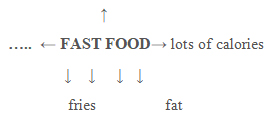
4. Try to continue the sentence: «We should be aware of what we eat because…..»
5. Do the task from 1-7, which of these sentences true, false, not stated
1. Fast food is more popular with people in their 30s than with
modern teenagers.
1) True
2) False
3) Not stated
2. Nowadays fast food portions are getting smaller.
1) True
2) False
3) Not stated
3. Tom Scarvell kept his collection of burgers in a large
fridge.
1) True
2) False
3) Not stated
4. Burgers from Tom Scarvell's collection looked the same for
years.
1) True
2) False
3) Not stated
5. It's possible to find some healthy food in McDonald's.
1) True
2) False
3) Not stated
6. Fast food dishes can help when you feel stressed out.
1) True
2) False
3) Not stated
7. McDonald's is cheaper than other fast food restaurants.
1) True
2) False
3) Not stated
TEXT 3
1. Before reading the text look at the title. Put down 5 nouns and 5 verbs, which reflect the main idea of the text. college,….. study,…..
Cambridge University
Cambridge University is the second-oldest university in the English-speaking world (after the University of Oxford) and the seventh-oldest in the world.
The story of Cambridge University begins in 1209 when several hundred students arrived in the little town of Cambridge after having walked 60 miles from Oxford. These students were all churchmen and had been studying in Oxford at that city's well-known schools. It was a hard life at Oxford for there was constant trouble, even fighting, between the citizens of the town and the students. Then one day a student accidentally killed a man of the town. The Mayor arrested three other students who were innocent and they were put to death. In protest, many students left Oxford, some of them went to Cambridge. And so the new University began.
It was Cambridge University. Of course, there were no Colleges in those early days and student life was very different from what it is now. Students were of all ages and came from anywhere and everywhere. Life in University was strict. Students were forbidden to play games, to sing (except sacred music), to hunt or fish or even to dance. Books were very rare and all the lessons were in the Latin language which students were supposed to speak even among themselves.
In 1440, King Henry VI founded King's College, and other colleges followed.
Nowadays there are more than 30 different colleges, including five for women students and several mixed colleges, in the University. The number of students in colleges is different: from 30 to 400 or 500.
The training course lasts 4 years. The academic year is divided into 3 terms. The students study natural and technical sciences, law, history, languages, geography, medicine, economics, agriculture, music and many other subjects. After 3 years of study a student may proceed to a Bachelor's degree, and later to the degrees of Master and Doctor.
There are many ancient traditions that are still observed at Cambridge. Students are required to wear gowns at lectures, in the University library, in the street in the evening, for dinners in the colleges and for official visits. One more tradition is to use Latin during public ceremonies of awarding degrees.
All the students must pay for their education, examinations, books, laboratories, university hostel, the use of libraries. The cost is high. It depends on college and university speciality. Very few students get grants.
Many great men studied at Cambridge, for example, Bacon (the philosopher), Milton and Byron (the poets), Cromwell (the soldier), Newton (the outstanding physicist), Darwin (who is famous for his theory of evolution) and Kapitsa (the famous Russian physicist).
2. After reading the text check your first task.
3. Make some questions with the following words
What? When? Who? Where? Why?
E.g. When did the story of Cambridge University begin?
Why was life in University strict?
4. Try to retell the text. These phrases will help you.
• the second-oldest university, in 1209, in 1440, more than 30 colleges, lasts 4 years, into 3 terms, ancient traditions, wear gowns, pay for the education.
Text № 5
Sports events
|
A Cricket Cricket is a nice and relaxing sport to watch. One game can last all day, so you will need to take a cushion with you. Some people take a picnic with them. People are usually very quiet while watching cricket. They only shout and clap when a player scores points for their team. Cricket is only played in the summer and is postponed if it rains. B. Tennis Most tennis competitions take place outside and need the weather to be warm and dry. There are few seats compared to other sports so it can be difficult to get tickets. These competitions can take all day so people take their own food and drinks with them. One of the rules of watching tennis is that you must be very quiet while the athletes are playing. When players score a point, the crowd claps. C. Skiing Skiing is a winter sport and lot of snow is needed. Skiing competitions take place in countries which have mountains. It can be very cold watching skiing. Most people take a special bottle with tea and coffee to keep them warm. There is a lot of waiting when watching a ski competition and when someone skis past, you only see them for about 10 seconds. D. Football Football can be a very noisy game and is played all year round. For the important matches, some stadiums can hold around 90, 000 people. Some people have to stand all the time. Football fans often have to travel a lot when their team plays away. You are not allowed to take your own food into the stadium. They sell hot food and drinks. E. Basketball Basketball is played outside and there are two teams that try to get the ball into the basket the most times. People who watch basketball are sometimes noisy but not as much as football fans, for example. Basketball can be played all year round and it doesn't matter what the weather like outside.You can't take food into the stadium, but members of staff go around the stadium selling cold snacks and drinks. F. Horse racing Horse racing is an event that lasts all day and has lots of different individual races. These events take place all year round and in all weathers except for snow or if the ground is frozen. Lots of people take picnics and can park their car near the race track. There are usually a few restaurants available with views of the race track. G. Beach volleyball This is a very popular sport in the summer by the seaside. Many games are played on public beaches, so anybody can do and watch. The players don't wear shoes because they are playing on the sand. As it is public, anyone can take food and drinks to the matches. But there is too much sand to have a picnic when watching beach volleyball. |
1. The people below are enjoy going to sports events. Decide which sports event would be the most suitable for the following people:
1. Jane loves the cold and drinking lots of tea. She puts on some warm clothes, makes a lot of tea and goes climbing to watch sports events. She doesn't watch sports in the summer. _________________
2. Paul doesn't like noisy sports. During the winter he doesn't go to any sports events. He likes going to an event with his friends and having a picnic. He hopes it doesn't rain. ___________________
3. Dean and Jim like watching team sports and follow their team all over the country. They like to stand and shout really loud when their team scores. They always buy burgers and chips at half time. _______________
4. When Helen is on her summer holiday, she gets up early in the morning and goes swimming. She then finds a nice place to sunbathe. From where she is, she can watch her favourite sport. __________________
5. Carol usually books her seats in advance for the event. In the morning she prepares some sandwiches to have during the event. She talks a lot and sometimes event staff tell her to be quiet. ___________
2. Put the correct word into the sentences:
Make a mind map with the root word sport using the lexis of the text
Text № 1
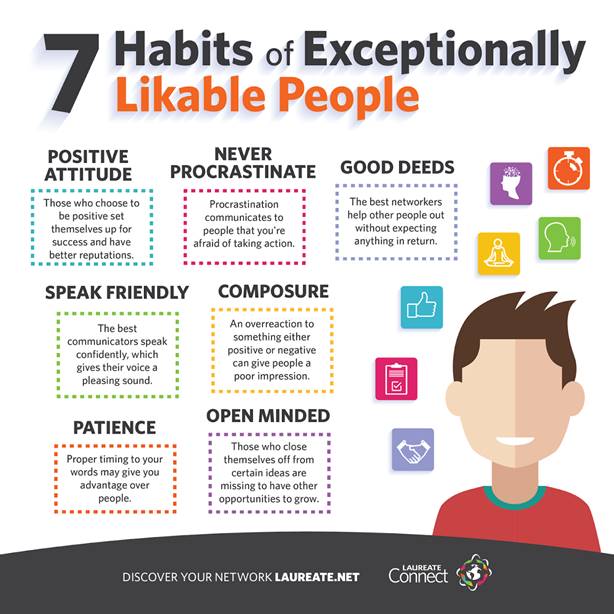
1. What is the main aim of this poster?
2. Read the sentences and write T (True), F (False), NS (Not stated):
A. The best networkers help other people out without expecting anything in return _____.
B. Those who choose to be rude to people have better reputation ______.
C. You can be likable only if you pay attention to your look _____.
D. People who communicate confidently are more successful _____.
E. If a person wants to be more successful he shouldn't show too much his emotions _____.
F. Successful people always try to prove their opinion _____.
G. If a person wants to be successful he should be always open to new ideas and experience ______.
3. Choose from the list other features of likable people and give a short description of them as in the text above:








Text № 2
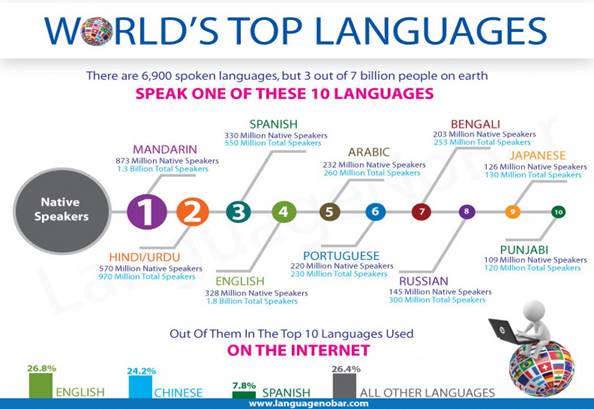
1. What is the aim of this poster?
2. Read the sentences and write T (true), F (false), NS (Not Stated):
a) Arabic language is more popular than Portuguese. ______
b) Bengali is the first language for 300 million people. _______
c) Punjabi is less spread than Hindi. _____
d) Spanish is the most popular language used on the Internet. ______
e) 145 million people speak Russian. ______
f) Itatian is as popular as Hindi. ______
g) 400 million people speak English. _______
h) Chinese language is on the second place after English in th Internet. ______
|
language |
countries |
Text № 3
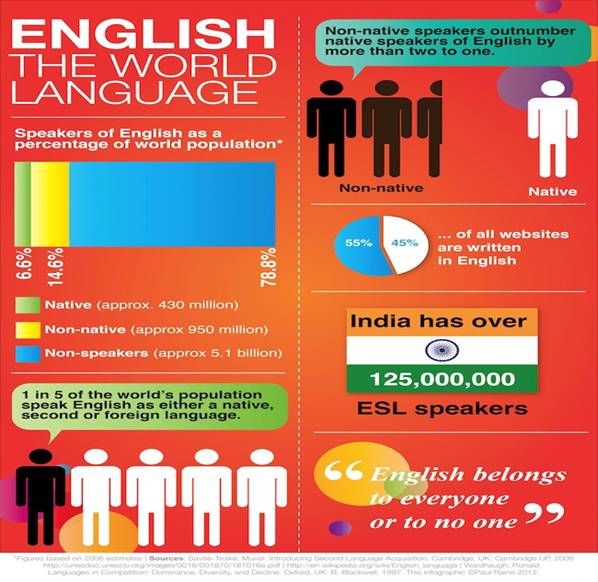
1. What is the main idea of this poster?
2. Complete the sentences with a right word:
a) There are approximately _______ billion of non-speakers.
b) Non-native speakers outnumber ________ speakers of English by more than two to one.
c) _____ % of websites are written in English.
d) There are 125,000,000 ESL speakers in _______.
e) 1 in 5 of the world's population speak English as either a native, ______ or foreign language.
f) English belongs to everyone or to _______.
3. Use the Internet resources and make the same poster for French.
Материалы на данной страницы взяты из открытых источников либо размещены пользователем в соответствии с договором-офертой сайта. Вы можете сообщить о нарушении.